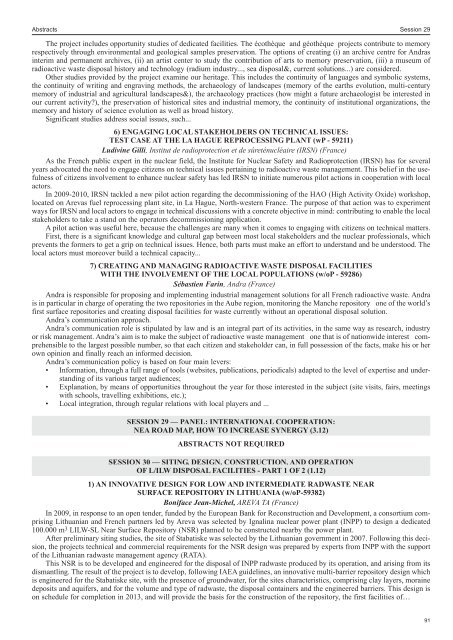ICEM11 Final Program 9.7.11pm_ICEM07 Final Program ... - Events
ICEM11 Final Program 9.7.11pm_ICEM07 Final Program ... - Events
ICEM11 Final Program 9.7.11pm_ICEM07 Final Program ... - Events
You also want an ePaper? Increase the reach of your titles
YUMPU automatically turns print PDFs into web optimized ePapers that Google loves.
Abstracts Session 29<br />
The project includes opportunity studies of dedicated facilities. The écothèque and géothèque projects contribute to memory<br />
respectively through environmental and geological samples preservation. The options of creating (i) an archive centre for Andras<br />
interim and permanent archives, (ii) an artist center to study the contribution of arts to memory preservation, (iii) a museum of<br />
radioactive waste disposal history and technology (radium industry..., sea disposal&, current solutions...) are considered.<br />
Other studies provided by the project examine our heritage. This includes the continuity of languages and symbolic systems,<br />
the continuity of writing and engraving methods, the archaeology of landscapes (memory of the earths evolution, multi-century<br />
memory of industrial and agricultural landscapes&), the archaeology practices (how might a future archaeologist be interested in<br />
our current activity?), the preservation of historical sites and industrial memory, the continuity of institutional organizations, the<br />
memory and history of science evolution as well as broad history.<br />
Significant studies address social issues, such...<br />
6) ENGAGING LOCAL STAKEHOLDERS ON TECHNICAL ISSUES:<br />
TEST CASE AT THE LA HAGUE REPROCESSING PLANT (wP - 59211)<br />
Ludivine Gilli, Institut de radioprotection et de sûreténucléaire (IRSN) (France)<br />
As the French public expert in the nuclear field, the Institute for Nuclear Safety and Radioprotection (IRSN) has for several<br />
years advocated the need to engage citizens on technical issues pertaining to radioactive waste management. This belief in the usefulness<br />
of citizens involvement to enhance nuclear safety has led IRSN to initiate numerous pilot actions in cooperation with local<br />
actors.<br />
In 2009-2010, IRSN tackled a new pilot action regarding the decommissioning of the HAO (High Activity Oxide) workshop,<br />
located on Arevas fuel reprocessing plant site, in La Hague, North-western France. The purpose of that action was to experiment<br />
ways for IRSN and local actors to engage in technical discussions with a concrete objective in mind: contributing to enable the local<br />
stakeholders to take a stand on the operators decommissioning application.<br />
A pilot action was useful here, because the challenges are many when it comes to engaging with citizens on technical matters.<br />
First, there is a significant knowledge and cultural gap between most local stakeholders and the nuclear professionals, which<br />
prevents the formers to get a grip on technical issues. Hence, both parts must make an effort to understand and be understood. The<br />
local actors must moreover build a technical capacity...<br />
7) CREATING AND MANAGING RADIOACTIVE WASTE DISPOSAL FACILITIES<br />
WITH THE INVOLVEMENT OF THE LOCAL POPULATIONS (w/oP - 59286)<br />
Sébastien Farin, Andra (France)<br />
Andra is responsible for proposing and implementing industrial management solutions for all French radioactive waste. Andra<br />
is in particular in charge of operating the two repositories in the Aube region, monitoring the Manche repository one of the world’s<br />
first surface repositories and creating disposal facilities for waste currently without an operational disposal solution.<br />
Andra’s communication approach.<br />
Andra’s communication role is stipulated by law and is an integral part of its activities, in the same way as research, industry<br />
or risk management. Andra’s aim is to make the subject of radioactive waste management one that is of nationwide interest comprehensible<br />
to the largest possible number, so that each citizen and stakeholder can, in full possession of the facts, make his or her<br />
own opinion and finally reach an informed decision.<br />
Andra’s communication policy is based on four main levers:<br />
• Information, through a full range of tools (websites, publications, periodicals) adapted to the level of expertise and understanding<br />
of its various target audiences;<br />
• Explanation, by means of opportunities throughout the year for those interested in the subject (site visits, fairs, meetings<br />
with schools, travelling exhibitions, etc.);<br />
• Local integration, through regular relations with local players and ...<br />
SESSION 29 — PANEL: INTERNATIONAL COOPERATION:<br />
NEA ROAD MAP, HOW TO INCREASE SYNERGY (3.12)<br />
ABSTRACTS NOT REQUIRED<br />
SESSION 30 — SITING, DESIGN, CONSTRUCTION, AND OPERATION<br />
OF L/ILW DISPOSAL FACILITIES - PART 1 OF 2 (1.12)<br />
1) AN INNOVATIVE DESIGN FOR LOW AND INTERMEDIATE RADWASTE NEAR<br />
SURFACE REPOSITORY IN LITHUANIA (w/oP-59382)<br />
Boniface Jean-Michel, AREVA TA (France)<br />
In 2009, in response to an open tender, funded by the European Bank for Reconstruction and Development, a consortium comprising<br />
Lithuanian and French partners led by Areva was selected by Ignalina nuclear power plant (INPP) to design a dedicated<br />
100.000 m3 LILW-SL Near Surface Repository (NSR) planned to be constructed nearby the power plant.<br />
After preliminary siting studies, the site of Stabatiske was selected by the Lithuanian government in 2007. Following this decision,<br />
the projects technical and commercial requirements for the NSR design was prepared by experts from INPP with the support<br />
of the Lithuanian radwaste management agency (RATA).<br />
This NSR is to be developed and engineered for the disposal of INPP radwaste produced by its operation, and arising from its<br />
dismantling. The result of the project is to develop, following IAEA guidelines, an innovative multi-barrier repository design which<br />
is engineered for the Stabatiske site, with the presence of groundwater, for the sites characteristics, comprising clay layers, moraine<br />
deposits and aquifers, and for the volume and type of radwaste, the disposal containers and the engineered barriers. This design is<br />
on schedule for completion in 2013, and will provide the basis for the construction of the repository, the first facilities of…<br />
91
















